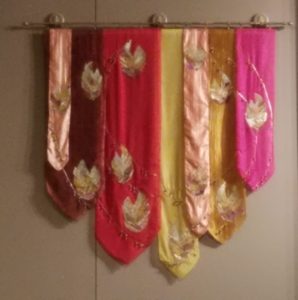
Diane Nymberg, who designed our beautiful Pentecost paraments, provided the following description of the rich symbolism in these wall hangings. (You may also download a pdf file with this description by clicking here.)
The Church’s liturgy inflames us with the Lord Jesus’ love and fills us with His grace. The liturgy sanctifies us and gives voice to our praise and glorification of God. Sacred Scripture, sacred music, and sacred art are essential ingredients of the Liturgy. These elements explain Jesus’s passion, death, and resurrection, give us spiritual nourishment, and prepare us to receive the Eucharist. They also help us cast our eyes in joyful expectation to Christ’s second coming. The design of the Pentecost wall hanging draws from salvation history, past, present, and future, to point us always to Jesus Christ, our Lord and Savior.
The first Christian Pentecost occurred during the ancient Jewish Festival of Weeks (Shavuot). This festival, also called Pentecost (Greek for “fiftieth”), fell exactly fifty days after Passover (Deut 16:9-12). Similar to our Thanksgiving, the Festival of Weeks celebrated the giving of the Law on Mt. Sinai and the end of the first wheat harvest. It drew thousands of Jewish pilgrims to Jerusalem from all over the Mediterranean, bringing with them the first fruits of the harvest. Undoubtedly, these pilgrims were among the crowd that witnessed the presence of the Holy Spirit and heard Peter speak (Acts 2: 5-11). Honey was among the “first fruits brought to Jerusalem, a reminder of the sweetness of the Law given on Mt. Sinai (Ps 119:103), as well as God’s promise to deliver the Israelites into the land flowing with milk and honey (Ex 3:8). The honey also pointed to the glory of the heavenly kingdom described in the book of Revelation and elsewhere in Scripture. In later times, milk also became a popular feature of the Holiday due to its scriptural connection with honey.
Incorporating these elements of salvation history, our Pentecost wall hangings consist of seven panels (a Biblical number signifying completeness, perfection) corresponding to the seven weeks between Easter and Pentecost. The seven panels touch or overlap each other and sway freely when swept by a breeze, suggesting the wind that accompanied the arrival of the Holy Spirit. The colors convey the intensity of the presence of the Holy Spirit – colors of fire, including deep red, fuchsia, orange, and yellow. The panels are adorned with twelve flames, reminders of the twelve apostles. The flames are composed from metallic ribbons of deep purples, reds, and oranges, but primarily gold and silver, symbolizing the Divine majesty of God the Holy Spirit.
Milk and honey are represented by pearls and carnelian – two gemstones forming the foundations and gates of the heavenly city of the New Jerusalem (Rev 21: 19-21). One hundred twenty gemstone pendants of pearls and carnelian are bound to the wall hangings representing the original 120 Christians who were there to receive the Holy Spirit (Acts 1:15). The Holy Spirit, working through Peter and the 120 disciples, produced a rich harvest of 3000 souls who were baptized later that day (Acts 2:41). So the wall hangings, like scripture and music, remind us of who we are, what we are called to be, and where we hope to live – eternally with God.
BIBLIOGRAPHY:
Rabbi Wayne Dosick, Living Judaism: The Complete Guide to Jewish Belief, Tradition & Practice. Harper Colins, 1995.
Paul Maier. In the Fullness of Time: A Historian Looks at Christmas, Easter, and the Early Church. Kregel Publications, 1997.
Joseph Cardinal Ratzinger. The Spirit of the Liturgy. Ignatius Press, 2000.
Sacrosanctum Concilium. Second Vatican Council, 1963.
Jane Yolen. Milk and Honey: A Year of Jewish Holidays. G.P. Putnam & Sons, 1996.

